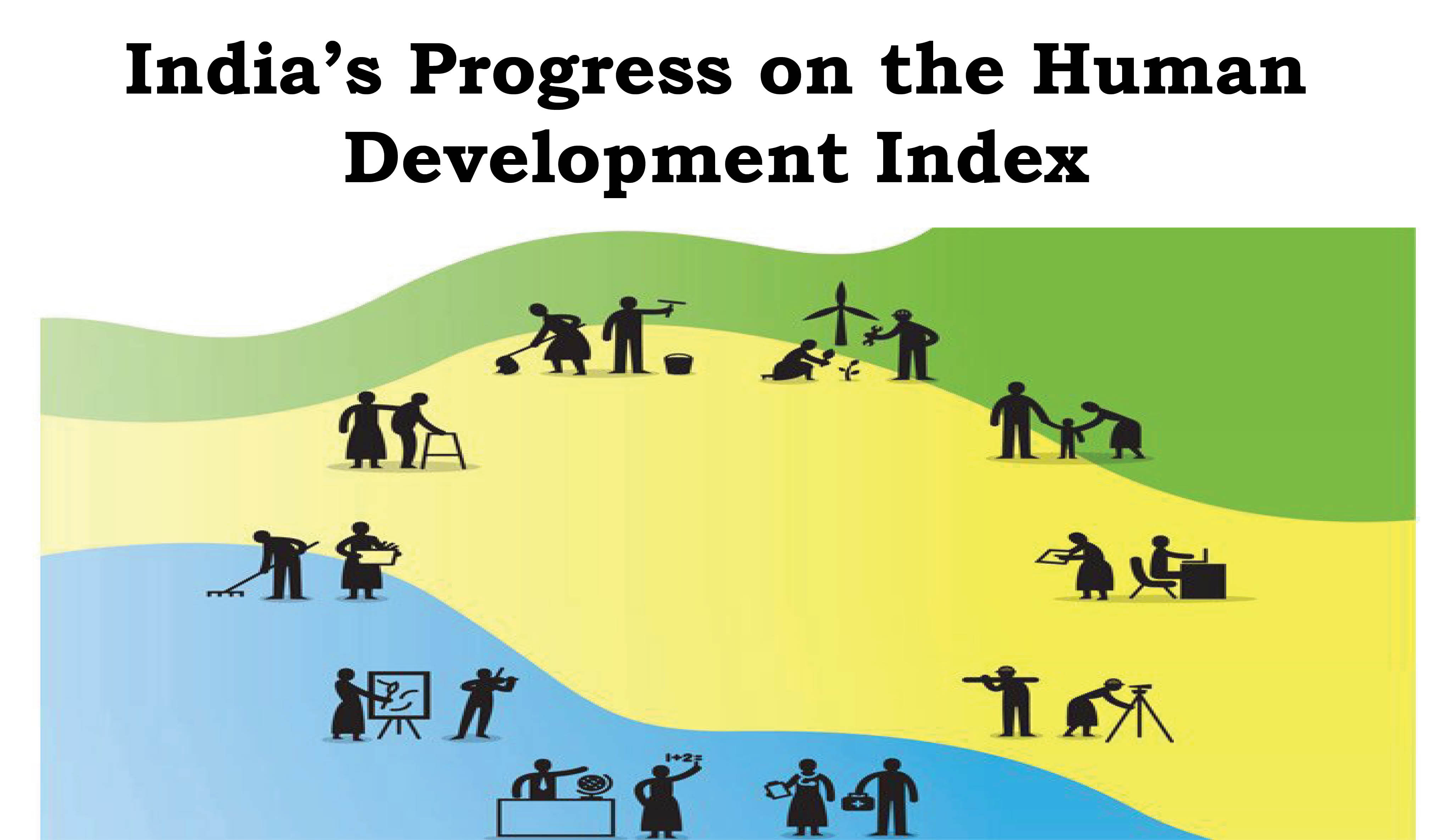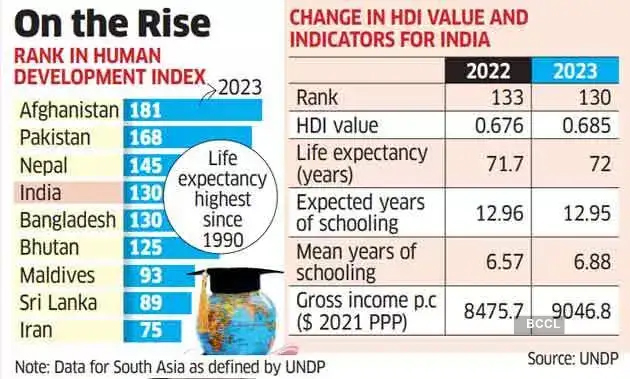India has seen significant improvements in human development, as highlighted in the United Nations Development Programme (UNDP) Human Development Report 2025. In 2023, India ranked 130th out of 193 countries, reflecting a three-point improvement from 133rd in 2022. This advancement in the Human Development Index (HDI) signals positive trends in key areas such as life expectancy, national income, and gender inequality. However, challenges remain, particularly in terms of inequality and gender development.
Key Metrics of Human Development in India:
1. Human Development Index (HDI):
India’s HDI score in 2023 stood at 0.685, positioning the country in the "medium human development" category. Although this score is still below the threshold of 0.700, required for high human development, India’s HDI has grown by over 53% since 1990. This remarkable improvement outpaces both the global and South Asian averages, driven primarily by economic growth and targeted social protection initiatives.
The HDI is composed of three key dimensions: health, education, and income. India’s advancements in these areas are noteworthy:
- Life Expectancy: Life expectancy at birth increased from 58.6 years in 1990 to 72 years in 2023, the highest since the inception of the index. This increase is partly attributed to the effectiveness of national health programs such as the National Rural Health Mission, Ayushman Bharat, and Janani Suraksha Yojana, which have significantly enhanced healthcare access across the country.
- Education: The expected years of schooling in India remained steady at 13 years in both 2022 and 2023. The mean years of schooling saw a slight improvement, rising from 6.6 years in 2022 to 6.9 years in 2023. These figures reflect the impact of educational reforms like the Right to Education Act and the National Education Policy 2020, though challenges persist regarding the quality of education.
- Income: India’s Gross National Income (GNI) per capita rose from $8,475 in 2022 to $9,047 in 2023, continuing a long-term upward trend. This increase is attributed to a combination of strong economic growth, increased investments, and inclusive programs like MGNREGA and Jan Dhan Yojana, which have contributed to poverty reduction.
2. Gender Inequality Index (GII):
India has also made notable progress in reducing gender inequality. In 2023, it ranked 102nd out of 193 countries on the GII, a significant improvement from 108th in 2022. While this reflects progress, India’s performance on the Gender Development Index (GDI) remains concerning, with a score of 0.874 in 2023. This score places India among countries in Group 5, which have relatively high gender gaps. The government’s focus on women’s empowerment, including the constitutional amendment reserving one-third of legislative seats for women, holds promise for further progress.
3. Multidimensional Poverty Reduction:
Between 2015-16 and 2019-21, approximately 135 million Indians escaped multidimensional poverty. This achievement is attributed to various welfare programs and economic growth, indicating that India’s social protection mechanisms have been effective in addressing poverty.
Challenges and Persistent Inequality:
Despite the progress India has made, the UNDP report highlights several areas of concern:
- Inequality: India’s HDI is significantly reduced by inequality, with the report noting that inequality accounts for a 30.7% loss in HDI, one of the highest in the region. Although progress has been made in health and education, disparities in income and gender remain substantial. Female labor force participation, political representation, and access to resources continue to lag behind male counterparts.
- Gender Disparities: While India’s GII ranking has improved, gender inequalities persist in many aspects of society. The low female labor force participation rate, alongside limited political representation, underscores the need for targeted policies to address these disparities.
Comparison with Other Nations:
- India shares the 130th rank with Bangladesh, with both countries categorized under "medium human development." Other neighboring nations like Nepal (145th) and Bhutan (125th) also fall under this category, while Pakistan, which ranks 168th, and Afghanistan, ranked 181st, are placed in the "low human development" category. In contrast, China (78th) and Sri Lanka (89th) maintain their positions in the "high human development" category, reflecting a broader disparity in regional development.
- Globally, Iceland topped the HDI rankings with a value of 0.972, followed by Norway and Switzerland. South Sudan, with an HDI value of 0.388, ranked the lowest, highlighting the vast gaps in development levels across the world.
Global Context: The Role of Artificial Intelligence:
The 2025 Human Development Report also explores the impact of Artificial Intelligence (AI) on global development. While global human development has stagnated, AI is seen as a potential catalyst for progress. According to the report, 60% of people are optimistic about AI’s ability to create new job opportunities. However, the report warns that unless new methods of development are explored, the world could face a significant delay in reaching the 2030 target for high human development. Inequality between countries with low HDI and those with very high HDI has been increasing, reversing a long-term trend of convergence.
Achim Steiner, UNDP Administrator, cautioned that the current slow pace of progress signals a threat to global development, making the world more vulnerable to economic and ecological shocks. He emphasized the need for a renewed focus on development to prevent further setbacks.
Conclusion
India’s progress in the Human Development Index reflects significant strides in improving life expectancy, education, and national income. However, challenges related to gender inequality, income disparity, and multidimensional poverty remain. As the country moves closer to achieving high human development, continued investment in social welfare programs and targeted interventions, especially for marginalized groups, will be critical.
The global context of stalled human development further underscores the urgency of innovative solutions, including leveraging emerging technologies like Artificial Intelligence, to reinvigorate progress on human development worldwide. India’s experience demonstrates that while significant gains have been made, there is still a long road ahead in ensuring that development is inclusive and equitable for all segments of society.
| Main question: Critically examine the progress made by India in terms of its Human Development Index (HDI) as per the UNDP Human Development Report 2025. Discuss the key factors contributing to India’s improvement in HDI and highlight the challenges that still persist in achieving higher human development. |








